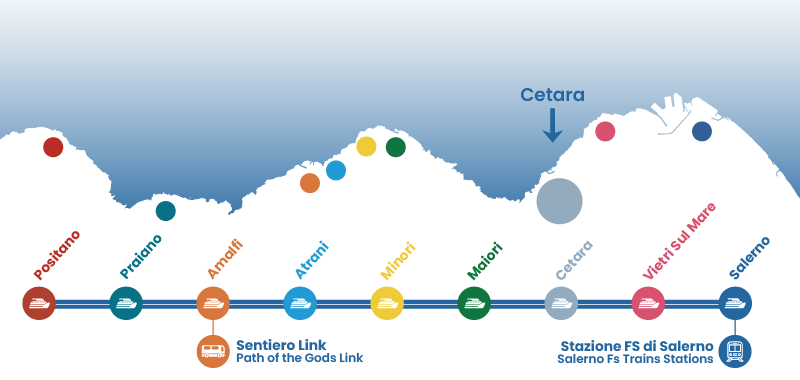Cetara
A paradise for food lovers! Famous for its anchovy sauce, this fishing village delights with its authentic flavors.
Cetara, the last "tonnara" on the Amalfi Coast
Arriving in Cetara feels like taking a dive into the past. The charm of this fishing village at the foot of Mount Falerio, protected as a UNESCO World Heritage Site, is truly priceless. The connection between its 2,000 inhabitants and the sea is evident even in the town's name, which likely derives from "Cetaria", meaning tuna fishery in Latin, or "cetari", referring to fishermen or merchants of large fish. For centuries, fish has not only been the staple food for the people of Cetara, but also a vital source of livelihood for local fishing families. Today, Cetara's fleet remains one of the most active in the Mediterranean, specializing in tuna and anchovy fishing as well as their processing and preservation.

The pride of Cetara's cuisine is the "Colatura di alici," a traditional recipe dating back to the ancient Romans, known as Garum. This method was revived in the Middle Ages by some monastic communities in the Amalfi Coast. During August, they used to preserve anchovies in wooden barrels, called mbuosti, with salt. As the anchovies salted, the brine would seep out through the gaps in the barrels, and this liquid was collected and preserved. Today, this delicious Cetara specialty is still marketed and used in famous recipes like Pesto Cetarese and Spaghetti with Colatura di Alici.
What to see and what to do in Cetara?
\1
The Torre Vicereale
The Torre Vicereale (Vice-Regal Tower) rises majestically on the east side of Cetara's beach and was built in the 16th century by the Angevins to defend the town from pirate attacks. It currently hosts a Civic Museum with the permanent exhibitions of works by numerous local painters, known as the "costaioli".
\2
The Church of San Francesco
The 17th century Church of San Francesco, with its dome painted by the artist Marco Benincasa, preserves a depiction of Sister Orsola Benincasa, the founder of the Order of the Teatine Sisters of the Immaculate Conception, who was originally from Cetara.
\3
The Church of San Pietro Apostolo
The Church of Saint Peter the Apostole was built in the 9th century to celebrate the expulsion of the Saracens and was renovated in the 18th century. Its beautiful majolica-tiled dome, the 13th-century bell tower, and the octagonal bell chamber are notable features. The church houses an ancient organ and a bilingual plaque (in Latin and Arabic) commemorating Grandenetto d'Ausilio, a Cetaran who played a key role in the liberation of Prince Frederick of Aragon, who was captured by the Salerno barons in 1484.
\4
The Church of Santa Maria di Constantinople
Dating from the 19th century, it houses a beautiful statue of Our Lady of Grace, which is carried in procession through the streets of the town every year at the beginning of June.
\5
Cetara, a seaside village
During the summer, the seaside village hosts the celebration of St. Peter with traditional fireworks over the sea on June 29. Additionally, at the end of July, it features the renowned cultural and gastronomic event “La Notte delle Lampare,” a celebration dedicated to Cetara's emblematic fish. A traditional fishing boat, cianciola, equipped with lamps, engages in a fishing expedition open to tourists, while on Cetara's beach, there are tastings of anchovy-based dishes served in various styles, along with other local specialties. The Torre Vicereale is also festively illuminated, and actors reenact a defense against a Saracen attack.




